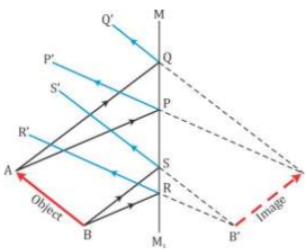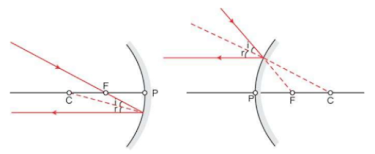ICSE Revision Notes for Reflection of Light Class 9 Physics
Chapter Name | Reflection of Light |
Topics Covered |
|
Related Study |
Reflection of Light
- The return of light into the same medium after striking a surface is called reflection.
- We see the objects around us due to reflection.
- A plane mirror reflects almost all the light falling on it.
Types of Reflection
Regular Reflection
- When a beam of light falls on a smooth and polished surface (a plane mirror), regular reflection occurs.
- The incident rays and reflected rays are parallel beams.
Irregular Reflection
- When a beam of light falls on a rough surface (a wall or a road), irregular reflection occurs.
- The incident rays are parallel beams, but the light reflected from different surfaces will reflect at different angles obeying the laws of reflection.
Terms Related to Reflection
- Incident ray: The light ray striking a reflecting surface is called the incident ray.
- Point of incidence: The point at which the incident ray strikes the reflecting surface is called the point of incidence.
- Reflected ray: The light ray obtained after reflection from the surface in the same medium as the incident ray is called the reflected ray.
- Normal: The perpendicular drawn to the surface at the point of incidence is the normal.
- Angle of incidence: The angle made by the incident ray with the normal at the point of incidence is called the angle of incidence.
- Plane of incidence: The plane containing the incident ray and the normal is called the plane of incidence.
- Angle of reflection: The angle made by the reflected ray with the normal at the point of incidence is called the angle of incidence.
- Plane of reflection: The plane containing the reflected ray and the normal is called the plane of incidence.
Laws of Reflection
∙ Reflection at a surface obeys two laws of reflection:
- First law of reflection: The incident ray, the normal to the surface at the point of incidence and the reflected ray, all lie in the same plane.
- Second law of reflection: The angle of incidence is equal to the angle of reflection.
Formation of Image by Reflection
There are two types of images—real and virtual images.
- Real image: It is the image which can be obtained on a screen. It is the image formed when light rays actually intersect after reflection. It is an inverted image.
- Virtual image: It cannot be obtained on a screen. It is the image formed when light rays do not actually intersect after reflection but appear to diverge from the image. The light rays intersect geometrically when they are produced backwards. It is an erect image.
Image of a Point Object Formed by a Plane Mirror
- ∙ OA and OB are the two rays from object O incident on a plane mirror MM′. They get reflected from the mirror by obeying the laws of reflection. AC and BD are the reflected rays.
- The image I is formed behind the mirror and is located by producing AC and BD backwards. This image is a virtual image because the reflected rays do not intersect actually.
Position of Image: The image I is as far behind the mirror as the object O is in front of it.
Image of an Extended Object Formed by a Plane Mirror
- An object AB is placed in front of a mirror MM′. Light rays travel from all points of the object in all directions.
- A′ is the virtual image of point A, and B′ is the virtual image of point B.
- In a similar way, all the points on object AB form virtual images on the mirror between A and B, giving rise to the virtual image A′B′ of AB.
- This image is erect and of the same size as the object. The perpendicular distance of each point behind the mirror is equal to the corresponding point of the object in front of the mirror.
Lateral Inversion
- The interchange of left and right sides in the image of an object in a plane mirror is called lateral inversion.
- Any symmetrical letter will appear as is after lateral inversion. Examples: A, H, I, M, O, T, U, V, W and X.
- The word, 'AMBULANCE' is written as
 on ambulances. If a car driver is driving infront of the ambulance then the image of the rear view mirror will appear normal to him and he can give way to the ambulance.
on ambulances. If a car driver is driving infront of the ambulance then the image of the rear view mirror will appear normal to him and he can give way to the ambulance.
Characteristics of the Image Formed by the Plane Mirror
The characteristics of the image formed by a plane mirror are
- The image formed by a plane mirror is always virtual and erect.
- The size of the image is equal to the size of the object, and the image is laterally inverted.
- The image formed by the plane mirror is as far behind the mirror as the object is in front of it.
Images Formed in Two Inclined Mirrors
- If n = 360/θ is odd, then the number of images formed is n when the object is placed asymmetrically between the two mirrors.
- If n = 360/θ is odd, then the number of images formed is n − 1 when the object is placed symmetrically between the two mirrors.
- If n = 360/θ is even, then the number of images formed is always n − 1 no matter how the object is placed between the two mirrors.
Images Formed by Two Mirrors Placed Parallel to Each Other
The number of images formed in this case will be infinite as n = 360/0 = ∞
Images Formed by Two Mirrors Placed Perpendicular to Each Other
In this case, 360/90 = 4. Thus, the number of images will be n − 1 = 3.
Uses of Plane Mirror
- An optician has a plane mirror mounted on the front wall where a patient sits and a sign board on the back wall.
- In a kaleidoscope, three plane mirrors are inclined at an angle of 60° to each other. This forms some very beautiful patterns with the help of a few glass pieces.
- In a barber’s shop, two mirrors face each other so that a person can see the hair at the back of the head.
- In a periscope, two mirrors are inclined at 45° with the vertical walls kept facing each other.
Spherical Mirrors
- A reflecting surface which is a part of a sphere is called a spherical mirror.
- A spherical mirror whose reflecting surface is curved outwards and polished on the inner spherical surface is a convex mirror.
- A spherical mirror whose reflecting surface is curved inwards and polished on the outer spherical surface is a concave mirror.
- The geometric centre of the reflecting surface of a spherical mirror is a point called the pole.
- The reflecting surface of a spherical mirror forms a part of a sphere. The centre of this sphere is called the centre of curvature of a spherical mirror. It is represented by C.
- The horizontal line passing through the centre of curvature and the pole of the spherical mirror is known as the principal axis.
- The radius of curvature of a spherical mirror is the radius of the sphere of which the reflecting surface of the spherical mirror is a part and is represented by R.
- The part of the mirror which is exposed to incident light is called the aperture of the mirror. Thus, it is the surface from which reflection occurs.
Focus and Focal Length
- The point at which a number of parallel rays intersect on the principal axis after reflecting from the mirror is called the principal focus of a concave mirror. It is represented by F.
- The point from which a number of parallel rays appear to emerge after reflecting from the mirror is called the principal focus of a convex mirror. It is also represented by F.
- The distance between the pole and the focus of the mirror is known as the focal length of the mirror. It is denoted as f.
- For spherical mirrors of small aperture, R = 2f.
Construction of Image: Ray Diagram
- There are certain rules to draw a ray diagram to locate the image formed by a spherical mirror.
- First rule: A ray of light passing through the centre of curvature of a concave mirror or a ray directed in the direction of the centre of curvature of a convex mirror is reflected along the same path after reflection.
- Second rule: A ray of light parallel to the principal axis, after reflection, passes through the principal focus in case of a concave mirror or appears to diverge from it in case of a convex mirror.
- Third rule: A ray passing through the principal focus of a concave mirror or a ray which is directed towards the principal focus of a convex mirror emerges parallel to the principal axis of the mirror after reflection.
- Fourth rule: A ray of light incident obliquely towards the pole of a mirror is reflected obliquely as per the laws of reflection. The angle of incidence is equal to the angle of reflection.
Ray diagrams for formation of images in Concave mirror
Case 1:
Case 2:Case 3:
Case 4(:Case 5:
Case 6:
Ray Diagrams for Formation of Images: Convex Mirror
Case 1:
Distinction of Mirrors without Touching
The mirror is held near the face and the image is seen. Three cases arise from this:
- Case (i): If the image is upright, of the same size as the object and does not change in size by moving the mirror towards or away from the face, then the mirror is a plane mirror.
- Case (ii): If the image is upright, magnified and increases in size by moving the mirror away from the face, then the mirror is a concave mirror.
- Case (iii): If the image is upright, diminished and decreases in size by moving the mirror away from the face, then the mirror is a convex mirror.
Sign Convention
The sign convention is as follows:
- All distances are measured from the pole of the mirror taken as origin. The rays are made incident from the left.
- The distances measured along the principal axis in the direction of incident light, are taken as positive, while those opposite to the incident light, are taken as negative.
- iii. Distances measured above the principal axis are taken as positive and those measured below the principal axis are taken as negative.
Mirror Formula
- The object distance, image distance and focal length are related as
1/u + 1/v = 1/f - Magnification is the ratio of the height of the image to the height of the object. It is represented as m.
m = Height of image (h')/Height of object (h) = h'/h - Magnification is also related to the object distance and the image distance as
m = h'/h = - (v/u)























